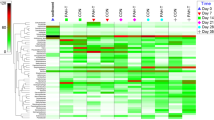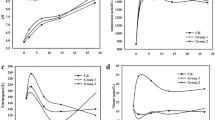Abstract
The seagrass meadows represent one of the highest productive marine ecosystems, and have the great ecological and economic values. Bacteria play important roles in energy flow, nutrient biogeochemical cycle and organic matter turnover in marine ecosystems. The seagrass meadows are experiencing a world-wide decline, and the pollution is one of the main reasons. Polycyclic aromatic hydrocarbons (PAHs) are thought be the most common. Bacterial communities in the seagrass Enhalus acoroides sediments were analyzed for their responses to PAHs induced stress. Dynamics of the composition and abundance of bacterial communities during the incubation period were explored by polymerase chain reaction denaturing gradient gel electrophoresis (PCR-DGGE) and quantitative PCR assay, respectively. Both the incubation time and the PAHs concentration played significant roles in determining the microbial diversity, as reflected by the detected DGGE bands. Analysis of sequencing results showed that the Gammaproteobacteria were dominant in the seagrass sediments, accounting for 61.29 % of all sequenced bands. As PAHs could be used as carbon source for microbes, the species and diversity of the PAH-added groups (group 1 and 2) presented higher Shannon Wiener index than the group CK, with the group 1 showing the highest values almost through the same incubation stage. Patterns of changes in abundance of the three groups over the experiment time were quite different. The bacterial abundance of the group CK and group 2 decreased sharply from 4.15 × 1011 and 6.37 × 1011 to 1.17 × 1010 and 1.07 × 1010 copies/g from day 2 to 35, respectively while bacterial abundance of group 1 increased significantly from 1.59 × 1011 copies/g at day 2 to 8.80 × 1011 copies/g at day 7, and then dropped from day 14 till the end of the incubation. Statistical analysis (UMPGA and PCA) results suggested that the bacterial community were more likely to be affected by the incubation time than the concentration of the PAHs. This study provided the important information about dynamics of bacterial community under the PAHs stress and revealed the high bacterial diversity in sediments of E. acoroides. Investigation results also indicated that microbial community structure in the seagrass sediment were sensible to the PAHs induced stress, and may be used as potential indicators for the PAHs contamination.







Similar content being viewed by others
References
Altschul SF, Madden TL, Schäffer AA, Zhang J, Zhang Z, Miller W, Lipman DJ (1997) Gapped BLAST and SI-BLAST: a new generation of protein database search programs. Nucl Acids Res 25:3389–3402
Bagwell CE, Rocque JR, Smith GW, Polson SW, Friez MJ, Longshore JW, Lovell CR (2002) Molecular diversity of diazotrophs in oligotrophic tropical seagrass bed communities. FEMS Microbiol Ecol 39:113–119
Cébron A, Beguiristain T, Faure P, Norini MP, Masfaraud JF, Leyval C (2009) Influence of vegetation on the in situ bacterial community and polycyclic aromatic hydrocarbon (PAH) degraders in aged PAH-contaminated or thermal-desorption-treated soil. Appl Environ Microbiol 75(19):6322–6330
Di Gennaro P, Moreno B, Annoni E, García-Rodríguez S, Bestetti G, Benitez E (2009) Dynamic changes in bacterial community structure and in naphthalene dioxygenase expression in vermicompost-amended PAH-contaminated soils. J Hazard Mater 172(2):1464–1469
Duarte CM, Holmer M, Marbà N (2005) Plant-microbe interactions in seagrass meadows. In: Kristensen E, Haese RR, Kostka JE (eds) Coastal and estuarine studies: interactions between macro-and microorganisms in marine sediment. American Geophysical Union, Washington, DC, pp 31–60
Fourquerean JW, Zieman JC (2002) Nutrient content of the seagrass Thalassia testudinum reveals regional patterns of relative availability of nitrogen and phosphorus in the Florida Keys USA. Biogeochemistry 61:229–245
Gan HM, Hudson AO, Rahman AYA, Chan KG, Savka MA (2013) Comparative genomic analysis of six bacteria belonging to the genus Novosphingobium: insights into marine adaptation, cell-cell signaling and bioremediation. BMC Genom 14:431. doi:10.1186/1471-2164-14-431
González N, Simarro R, Molina MC, Bautista LF, Delgado L, Villa JA (2011) Effect of surfactants on PAH biodegradation by a bacterial consortium and on the dynamics of the bacterial community during the process. Bioresour Technol 102(20):9438–9446
Green-García AM, Engel AS (2012) Bacterial diversity of siliciclastic sediments in a Thalassia testudinum meadow and the implications for Lucinisca nassula chemosymbiosis. Estuar Coast Shelf Sci 112:153–161
Guazzaroni ME, Herbst FA, Lores I, Tamames J, Peláez AI, López-Cortés N, Alcaide M, Del Pozo MV, Vieites JM, von Bergen M, Gallego JL, Bargiela R, López-López A, Pieper DH, Rosselló-Móra R, Sánchez J, Seifert J, Ferrer M (2013) Metaproteogenomic insights beyond bacterial response to naphthalene exposure and bio-stimulation. ISME J 7:122–136
Heather G (2010) The microbial role in carbon cycling within seagrass sediments. Plymouth Student Sci 3(1):234–244
Hong YG, Xu XR, Kan JJ, Chen F (2014) Linking seasonal inorganic nitrogen shift to the dynamics of microbial communities in the Chesapeake Bay. Appl Microbiol Biotechnol 98:3219–3229
Ikenaga M, Guevara R, Dean AL, Pisani C, Boyer JN (2010) Changes in community structure of sediment bacteria along the Florida Coastal Everglades marsh-mangrove -seagrass salinity gradient. Microb Ecol 59:284–295
James JB, Sherman TD, Devereux R (2006) Analysis of bacterial communities in seagrass bed sediments by double-gradient denaturing gradient gel electrophoresis of PCR-amplified 16S rRNA genes. Microb Ecol 52:655–661
Jensen SI, Kühl M, Priemé A (2007) Different bacterial communities associated with the roots and bulk sediment of the seagrass Zostera marina. FEMS Microbiol Ecol 62:108–117
Jiang Z, Huang X, Zhang J, Zhou C, Lian Z, Ni Z (2014) The effects of air exposure on the desiccation rateand photosynthetic activity of Thalassia hemprichii and Enhalus acoroides. Mar Biol 161(5):1051–1061
Jones BW, Cifuentes LA, Kaldy JE (2003) Stable carbon isotope evidence for coupling between sedimentary bacteria and seagrasses in a sub-tropical lagoon. Mar Ecol Prog Ser 255:15–25
Lai QL, Wang LP, Wang WP, Shao ZZ (2012) Genome sequence of Idiomarina xiamenensis type strain 10-D-4. J Bacteriol 194(24):6938. doi:10.1128/JB.01855-12
Larkum AWD, Orth RJ, Duarte CM (eds) (2006) Seagrasses: biology, ecology and conservation. Springer, Dordrecht
Ling J, Dong JD, Wang YS, Zhang YY, Deng C, Lin L, Wu ML, Sun FL (2012) Spatial variation of bacterial community structure of the Northern South China Sea in relation to water chemistry. Ecotoxicoloy 21(6):1669–1679
Maidak BL, Cole JR, Parker CT Jr, Garrity GM, Larsen N, Li B, Lilburn TG, McCaughey MJ, Olsen GJ, Overbeek R, Pramanik S, Schmidt TM, Tiedje JM, Woese CR (1999) A new version of the RDP (Ribosomal Database Project). Nucl Acids Res 27:171–173
Muyzer G, Smalla K (1998) Application of denaturing gradient gel electrophoresis (DGGE) and temperature gradient gel electrophoresis (TGGE) in microbial ecology. Anton Leeuw Int J G 73:127–141
Muyzer G, de Waal EC, Uitterlinden AG (1993) Profiling of complex microbial populations by denaturing gradient gel electrophoresis analysis of polymerase chain reaction amplified genes encoding for 16S rRNA. Appl Environ Microbiol 59:695–700
Nealson KH (1997) Sediment bacteria: who’s there, what are they doing, and what’s new? Annu Rev Earth Planet Sci 25:403–434
Ortmann AC, Ortell N (2014) Changes in free-living bacterial community diversity reflect the magnitude of environmental variability. FEMS Microbiol Ecol 87(1):291–301
Peng JJ, Cai C, Qiao M, Li H, Zhu YG (2010) Dynamic changes in functional gene copy numbers and microbial communities during degradation of pyrene in soils. Environ Pollut 158:2872–2879
Raja S, Thangaradjou T, Sivakumar K, Kannan L (2012) Rhizobacterial population density and nitrogen fixation in seagrass community of Gulf of Mannar, India. J Environ Biol 33(6):1033–1037
Ren L, Huang XD, McConkey BJ, Dixon DG, Greenberg BM (1994) Photoinduced toxicity of three polycyclic aromatic hydrocarbons (Fluoranthene, Pyrene, and Naphthalene) to the duckweed Lemna gibba L. G-3. Ecotox Environ Safe 28:160–171
Ren G, Ren W, Teng Y, Li Z (2015) Evident bacterial community changes but only slight degradation when polluted with pyrene in a red soil. Front Microbiol 6:22
Saitou N, Nei M (1987) The neighbor-joining method: a new method for reconstructing phylogenetic trees. Mol Biol Evol 4:406–425
Short FT, Polidoro B, Livingstone SR, Carpenter KE, Bandeira S, Bujang JS, Calumpong HP, Carruthers TJB, Coles RG, Dennison WC, Erftemeijer PLA, Fortes MD, Freeman AS, Jagtap TG, Kamal AHM, Kendrick GA, Kenworthy WJ, Nafie YAL, Nasution IM, Orth RJ, Prathep A, Sanciangco JC, Tussenbroek BV, Vergara SG, Waycott M, Zieman JC (2011) Extinction risk assessment of the world’s seagrass species. Biol Conserv 144:1961–1971
Sohn JH, Kwon KK, Kang JH, Jung HB, Kim SJ (2004) Novosphingobium pentaromativorans sp. nov., a high-molecular-mass polycyclic aromatic hydrocarbon-degrading bacterium isolated from estuarine sediment. Int J Syst Evol Microbiol 54(5):1483–1487
Sun FL, Wang YS, Sun CC, Peng YL, Deng C (2012) Effects of three different PAHs on nitrogen-fixing bacterial diversity in mangrove sediment. Ecotoxicology 21:1651–1660
Suzuki MT, Giovannoni SJ (1996) Bias caused by template annealing in the amplification of mixtures of 16S rRNA genes by PCR. Appl Environ Microbiol 62:625–630
Tabor S, Richardson CC (1987) DNA sequence analysis with a modified bacteriophage T7 DNA polymerase. Proc Natl Acad Sci USA 84:4767–4771
Tamura K, Peterson D, Peterson N, Stecher G, Nei M, Kumar S (2011) MEGA5: molecular evolutionary genetics analysis using maximum likelihood, evolutionary distance, and maximum parsimony methods. Mol Biol Evol 28:2731–2739
Thorhaug A (1986) Review of seagrass restoration effort. Ambio 15:110–117
Uku J, Björk M, Bergman B, Díez B (2007) Characterization and comparison of prokaryotic epiphytes associated with three east African seagrasses. J Phycol 43:768–779
Viñas M, Sabaté J, Espuny MJ, Solanas AM (2005) Bacterial community dynamics and polycyclic aromatic hydrocarbon degradation during bioremediation of heavily creosote-contaminated soil. Appl Environ Microbiol 71(11):7008–7018
Wang YS, Huang YJ, Chen WC, Yen JH (2009) Effect of carbendazim and pencycuron on soil bacterial community. J Hazard Mater 172:84–91
Wang LP, Lai QL, Fu YY, Chen H, Wang WP, Wang JN, Sun FQ, Shao ZZ (2011) Idiomarina xiamenensis sp. nov., isolated from surface seawater, and proposal to transfer Pseudidiomarina aestuariito the genus Idiomarina asIdiomarina aestuarii comb. nov. Int J Syst Evol Microbiol 61:969–973
Waycott M, Duarte CM, Carruthers TJB, Orth RJ, Dennison WC, Olyarnik S, Calladine A, Fourqurean JW, Heck KL, Hughes AR, Kendrick GA, Kenworthy WJ, Short FT, Williams SL (2009) Accelerating loss of seagrasses across the globe threatens coastal ecosystems. P Natl Acad Sci 106:12377–12381
Wu HB, Chen W, Wang GH, Dai SK, Zhou DY, Zhao HZ, Guo YT, Ouyang YC, Li X (2012) Culture-dependent diversity of Actinobacteria associated with seagrass (Thalassia hemprichii). Afr J Microbiol 6:87–94
Wu P, Wang YS, Sun CC, Sun FL, Wang YT (2013) Microbial community shift with decabromodiphenyl ether (BDE 209) in sediments of the Pearl River estuary, China. Biologia 68(5):788–796
Yan QY, Yu YH, Feng WS et al (2008) Plankton community composition in Three Gorges Reservoir region revealed by PCR-DGGE and its relationships with environmental factors. J Environ Sci 20:732–738
Zhang YY, Dong JD, Yang ZH, Zhang S, Wang YS (2008) Phylogenetic diversity of nitrogen-fixing bacteria in mangrove sediments assessed by PCR-denaturing gradient gel electrophoresis. Arch Microbiol 190:19–28
Zhang YY, Dong JD, Yang B, Ling J, Wang YS, Zhang S (2009) Bacterial community structure of mangrove sediments in relation to environmental variables accessed by 16S rRNA gene-denaturing gradient gel electrophoresis fingerprinting. Sci Mar 73:487–498
Zhou HW, Wong AHY, Yu RMK, Park YD, Wong YS, Tam NFY (2008) Polycyclic aromatic hydrocarbon-induced structural shift of bacterial communities in mangrove sediment. Microbiol Ecol 58:153–160
Acknowledgments
The research was supported by the National Natural Science Foundation of China (41406191, 41276113, 41276114 and 41430966), the National High Technology Research and Development Program of China (863 Program, 2012AA092104, 2013AA092901, 2013AA092902), Strategic Priority Research Program of the Chinese Academy of Sciences (XDA11020202), the Knowledge Innovation Program of the Chinese Academy of Sciences (SQ201218), the Open Fund of Key Laboratory for Ecological Environment in Coastal Areas, State Oceanic Administration (201211, 201304), MEL Young Scientist Visiting Fellowship of State Key Laboratory of Marine Environment Science, Xiamen University (MELRS1221), Science and technology cooperation projects of Sanya (2013YD74).
Conflict of interest
The authors declare that they have no conflict of interest associated with this publication.
Author information
Authors and Affiliations
Corresponding authors
Rights and permissions
About this article
Cite this article
Ling, J., Jiang, YF., Wang, YS. et al. Responses of bacterial communities in seagrass sediments to polycyclic aromatic hydrocarbon-induced stress. Ecotoxicology 24, 1517–1528 (2015). https://doi.org/10.1007/s10646-015-1493-x
Accepted:
Published:
Issue Date:
DOI: https://doi.org/10.1007/s10646-015-1493-x




